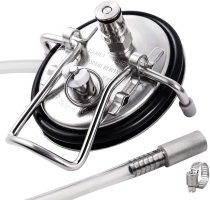I purchased one of these on Amazon about 6 months ago and find it just doesn't maintain the set pressure. I've tried replacing the seal and over-pressurizing the beer to 35 psi and it still leaks.
Being it cost half of what it sells for from Morebeer are these just junk and I need to ante-up and buy a better one? They look identical so I'm hesitant.
And then the question is do I really need one. Once I transfer my beer into a keg it sits in it for 2-4 weeks. Would I been fine just not using one of these?
Being it cost half of what it sells for from Morebeer are these just junk and I need to ante-up and buy a better one? They look identical so I'm hesitant.
And then the question is do I really need one. Once I transfer my beer into a keg it sits in it for 2-4 weeks. Would I been fine just not using one of these?




